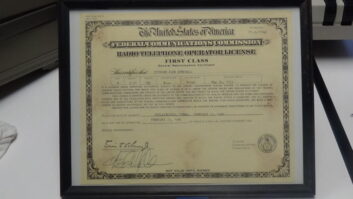
A technician operates the radio console at Gorakhkali Radio in Western Nepal, Pokhara city; Photo: Santosh Devkota
KATHMANDU, Nepal —Westerners associate the Himalayan country of Nepal with ancient Hindu temples, chanting Buddhist monks and romantic echoes of the mythical paradise of Shangri-La.
In reality, Nepal is a modernizing, if isolated and impoverished, Asian country where FM radio is king.
“When it comes to the penetration of FM radio stations, Nepal is one of the most successful countries in the world,” said Santosh Devkota. He is managing director of Cool Tool Digital Media Pvt. Ltd. (DigiMed), an FM radio consultancy/training firm located in Kathmandu.
Prior to this, Devkota was a broadcaster/producer at Radio Birgunj 99 FM (radiobirgunj.com) in Parsa, Nepal. “To date, over 300 FM stations are on air, with 435 licenses having been issued,” he said.

Mid Terai’s first FM station, on air since Dec. 13, 2002, is located in central region Nepal, Birgunj, Parsa District; Photo by Santosh Devkota There are so many stations, in fact, that advertising revenues are taking a pounding. “I still remember back between 2003 to 2008, when we charged 150 Nepalese rupees (NPR) on a single 15-second commercial slot in Birgunj city,” said one Nepali radio source, who requested anonymity for fear of offending potential clients. “Today, the minimum price for a one-minute commercial is NPR20 to NPR50.”
Brief snapshot
Nepal’s population is just under 30 million people, who live in an area slightly larger than Arkansas. According to the CIA World Factbook(www.cia.gov),80.6 percent are Hindu, 10.7 percent are Buddhist and 4.2 percent are Muslim. Nepal is one of the poorest and least developed countries in the world. Its economy is based mainly on agriculture, and only about a fifth of its population lives in urban areas.
Despite its reputation as a Himalayan refuge, only the northern part of Nepal is mountainous. As you move south, into the area of rivers that feed the Ganges, the mountains give ways to hills, and then a flat plain. This explains how Nepal’s economy can be agriculture-based. About 75 percent of the population works on the land, growing rice, corn (maize), wheat, millet, barley and coffee.
Radio’s progression
Until 1951, there was no local radio in Nepal. But things changed on April 1of that year when the then-kingdom launched Radio Nepal in Kathmandu. Service began with a 250 W transmitter broadcasting on shortwave. Today, this state-owned service covers the country with shortwave, and reaches up to 80 percent of the population using AM (medium-wave) and FM.<
It wasn’t until the mid-1990s that the government opened up the FM band to non-governmental private stations. (Nepal has undergone decades of political upheaval and social revolt, with the country becoming a federal republic in 2008.) That license went to Hits FM 91.2 (www.hitsfm.com.np),which went on air in April 1996.
Anup Sharma, Radio Kantipur’s chief of engineering. Although some AM stations exist, FM is the overwhelmingly preferred medium for private broadcasting due to its superior audio quality.
Radio Kantipur (96.1 FM; radiokantipur.com) received its license in October 1998. The station is part of the Kantipur Media Group, which also operates the national Kantipur TV network, newspapers and websites in Nepal. A 24-hour source of news, music and entertainment, “Radio Kantipur has its main/central station located in Pulchowk, Lalitpur with seven relay stations outside Kathmandu valley in major cities all over Nepal,” said.
Anup Sharma, Radio Kantipur’s chief of engineering. Frequencies used are either 96.1 or 101.8 MHz, with transmitters operating at either 1 kW or 10 kW depending on the terrain and area being covered.
The main Radio Kantipur facility in Pulchowk has three studios for on-air/recording, plus a fourth for news. The station has redundant production and transmission equipment, with the on-air side being “computerized,” Sharma said. “We use radio automation software to control our on-air broadcasts. Meanwhile, Adobe Audition is used for recording and production.”
The dilemma
Radio Kantipur is in the front rank of Nepal’s most professional radio stations. But there are hundreds of smaller stations with lesser resources, operating either as commercial (advertising revenue) or community (donation) broadcasters.
This is where the problem comes in: The government’s willingness to grant licenses has led to explosive growth, and a glut of stations chasing ad rupees. In addition, Nepal’s ongoing political instability has weakened the economy, resulting in fewer NPRs chasing more available airtime. According to Santosh Devkota — based on interviews he has done with Nepali broadcasters — the result is that the number of FM stations has grown faster than the economy’s ability to support them.
A Nepali listening to his radio in the Butwal bazaar, Rupandehi; Photo by Santosh Devkota
Meanwhile, TV is starting to cut into Nepal’s radio audience. So is streaming media via the Internet. In this latter instance, the growing popularity of broadband Internet at home and via smartphones is fueling the growth of homegrown online radio stations.
“Thousands of Nepalese listen to online radio using laptops [and] smartphones, and 12 percent of all Internet users are already using online radios regularly,” Devkota said. “By the end of March 2012, there were already about 250 Nepalese online radio stations — approximately 150 more than in 2009–2010 … Listenership on mobile phones has also grown noticeably. Today, about quarter half of all online radio stations are also available on smartphones.”
Continuing financial and political instability in Nepal, coupled with the over-abundance of FM airtime for advertisers, means that the future of the country’s broadcasters looks uncertain.
Uncertain, however, does not mean doomed. The fact that Nepal is host to hundreds of commercial and community FM broadcasters, coupled with the growth of online broadcasting, means that radio has become an established and vital part of this country’s culture, politics and economics notwithstanding.
James Careless reports on the industry for Radio World from Ottawa, Ontario.












